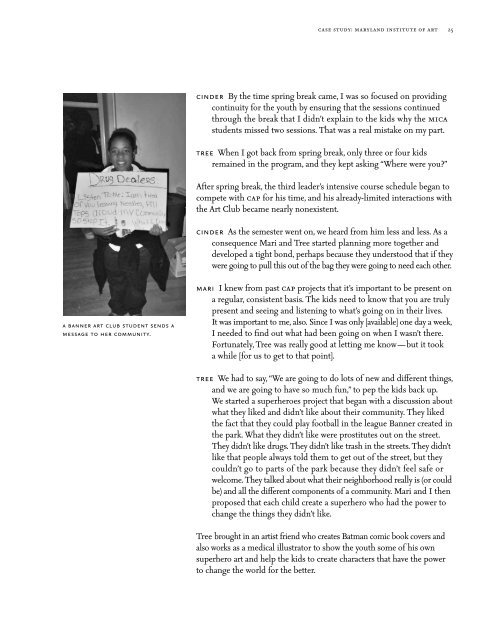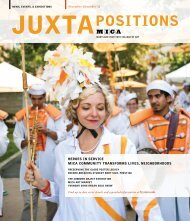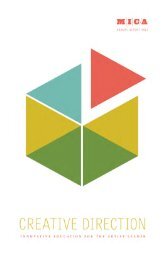art/vision/voice - Maryland Institute College of Art
art/vision/voice - Maryland Institute College of Art
art/vision/voice - Maryland Institute College of Art
Create successful ePaper yourself
Turn your PDF publications into a flip-book with our unique Google optimized e-Paper software.
a banner <strong>art</strong> club student sends a<br />
message to her community.<br />
case study: maryland institute <strong>of</strong> <strong>art</strong> 25<br />
cinder By the time spring break came, I was so focused on providing<br />
continuity for the youth by ensuring that the sessions continued<br />
through the break that I didn’t explain to the kids why the mica<br />
students missed two sessions. That was a real mistake on my p<strong>art</strong>.<br />
tree When I got back from spring break, only three or four kids<br />
remained in the program, and they kept asking “Where were you?”<br />
After spring break, the third leader’s intensive course schedule began to<br />
compete with cap for his time, and his already-limited interactions with<br />
the <strong>Art</strong> Club became nearly nonexistent.<br />
cinder As the semester went on, we heard from him less and less. As a<br />
consequence Mari and Tree st<strong>art</strong>ed planning more together and<br />
developed a tight bond, perhaps because they understood that if they<br />
were going to pull this out <strong>of</strong> the bag they were going to need each other.<br />
mari I knew from past cap projects that it’s important to be present on<br />
a regular, consistent basis. The kids need to know that you are truly<br />
present and seeing and listening to what’s going on in their lives.<br />
It was important to me, also. Since I was only [available] one day a week,<br />
I needed to find out what had been going on when I wasn’t there.<br />
Fortunately, Tree was really good at letting me know—but it took<br />
a while [for us to get to that point].<br />
tree We had to say, “We are going to do lots <strong>of</strong> new and different things,<br />
and we are going to have so much fun,” to pep the kids back up.<br />
We st<strong>art</strong>ed a superheroes project that began with a discussion about<br />
what they liked and didn’t like about their community. They liked<br />
the fact that they could play football in the league Banner created in<br />
the park. What they didn’t like were prostitutes out on the street.<br />
They didn’t like drugs. They didn’t like trash in the streets. They didn’t<br />
like that people always told them to get out <strong>of</strong> the street, but they<br />
couldn’t go to p<strong>art</strong>s <strong>of</strong> the park because they didn’t feel safe or<br />
welcome. They talked about what their neighborhood really is (or could<br />
be) and all the different components <strong>of</strong> a community. Mari and I then<br />
proposed that each child create a superhero who had the power to<br />
change the things they didn’t like.<br />
Tree brought in an <strong>art</strong>ist friend who creates Batman comic book covers and<br />
also works as a medical illustrator to show the youth some <strong>of</strong> his own<br />
superhero <strong>art</strong> and help the kids to create characters that have the power<br />
to change the world for the better.
















